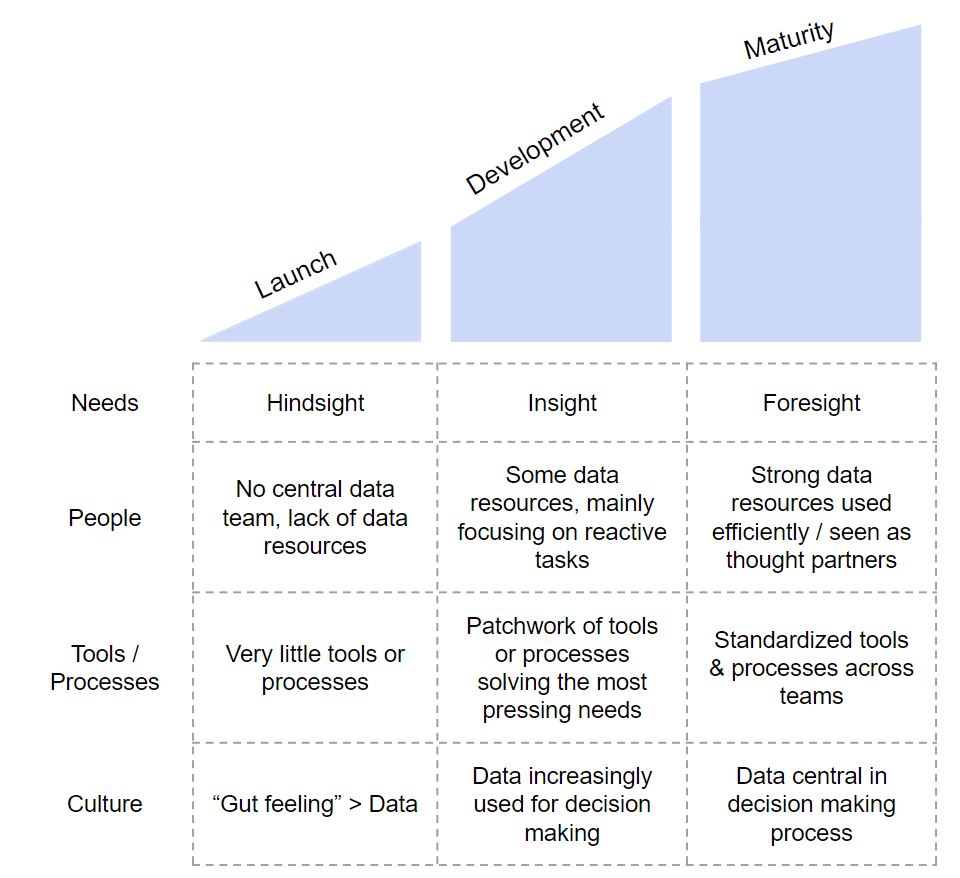Understanding "Analytical maturity"
A simple framework to pinpoint what are the analytical needs of your organization and how to make it more data-driven.
Understanding your organization’s analytical maturity can give you a strong edge as a data professional. It will make your “non-analytical” decisions better informed (from “project prioritization” to “how to present your findings”) and help you formulate a long-term goal. And that’s truly an edge - not a lot of data professionals are taking this step back to design long-term goals (and even fewer are delivering against these long-term goals).
This article is part 1 of a 3 series of articles on Analytical Maturity:
Part 1: Understanding Analytical Maturity
Part 2: Moving stages
Part 3: What’s a “mature” organization
Let’s dive in!
Any organization (team, product, company, etc.) at a given time is at a certain stage of analytical maturity. Just like humans who “crawl, walk and then run”, organizations go through the same stages. It is one of those immutable laws of nature: everything goes through creation, development, and maturity.
Analytical maturity is a function of 4 key components:
The needs: Robert D. Peng and Elizabeth Matsui wrote in “The Art of Data” that there are 6 main types of questions: Descriptive, Exploratory, Inferential, Predictive, Causal and Mechanistic. The type of questions you are being asked are usually a great indicator of the level of maturity of your org - a low-maturity org will be mostly interested in descriptive and exploratory data studies, vs an advanced-maturity org that will ask more predictive and causal questions.
The people: another key component to analytical maturity is the people, both in terms of capabilities and capacities. Depending on how many data resources the organization has and how good their capacities are
The tools & processes: are there standardized tools for the data professional? Do we have standardized processes (e.g. prioritization, templates, etc.) for the data team?
The culture: what’s the split between intuition and data in decision-making?
Depending on how your organization scores on each of those components, it will fall into one of these 3 stages:
The launch stage: At this stage, the organization needs basic reporting to know what has already happened (“in hindsight”). There is no central data team, you might not even have data analysts - data studies are being done by a few data-savvy operators on top of their 9-5 jobs. There is also no tooling, no process, and no clear agreement on what lens should be used when looking at a particular phenomenon. This leads to a lot of noise (e.g. multiple teams with different churn definitions that lead to disagreement down the road). On the cultural side, while everyone agrees that data should inform the decision-making process, due to the lack of data (or the mistrust in the data) a lot of decisions are being made via “informed gut feeling”.
The development stage: The organization has good visibility of its market and for some of the key metrics it should be tracking. Now it needs to understand why things are evolving in a certain way (“insight”). Teams start being supported by data professionals (either embedded inside them or within a centralized data team). The data infrastructure is slowly shifting from Google Spreadsheets to more robust tooling. To triage and prioritize all of the data requests r, the first few data professionals establish basic prioritization principles and a ticketing system (i.e. Google Form). Common lenses are being adopted across teams, and as a result, data is more and more relied upon for decision-making. Non-data professionals become smarter on what data questions to ask, With tooling, non-data professionals can look at the data themselves
The maturity stage: The organization understands why things are moving in a certain way and can now predict and influence future changes (“foresight”). Centralized data teams start forming, acting as proactive thought partners (vs “reactive support” from the previous stage). Tools, processes, and metrics are being standardized. Data is expected in every decision-making process
The image above is a simplification of the real life. In reality, organizations can score very differently on each component - but you get the gist of it. The beauty of this framework is that:
It gives you a structured way to discover the critical factors hindering your organization’s analytical growth.
It allows you to pinpoint where your org is in its journey - and what’s next for it.
That’s really why you get a strong edge when you know how to use this framework: it gives you a way to understand where you are and where you could be, and to diagnose why you are not there yet. Your job then is “only” to set a strategy to remove the roadblocks - which is exactly what we’ll see in the next article, in which we will be talking about the book “Good Strategy, Bad Strategy”, and how we can merge its framework and the one I just presented to come up with a good strategy to move the analytical maturity of your organization. strategy to move the analytical maturity, with some examples of actions to take.


